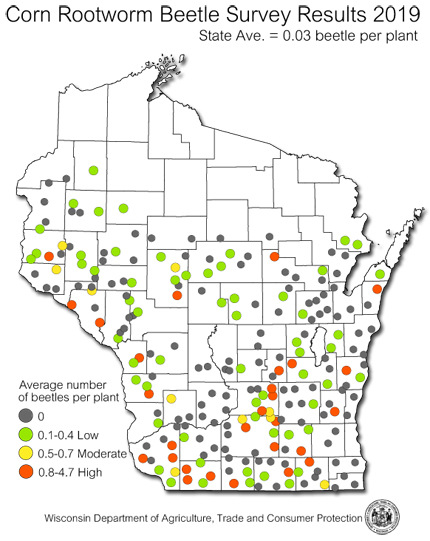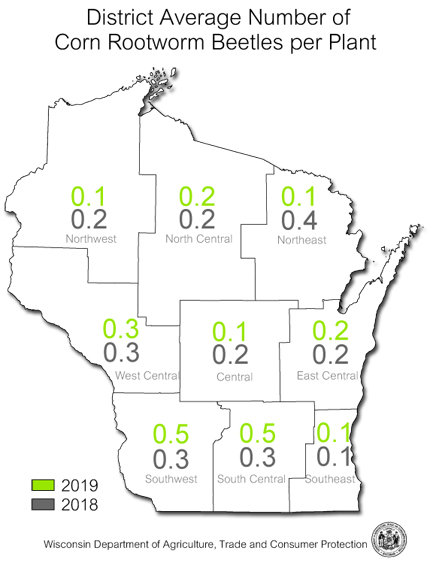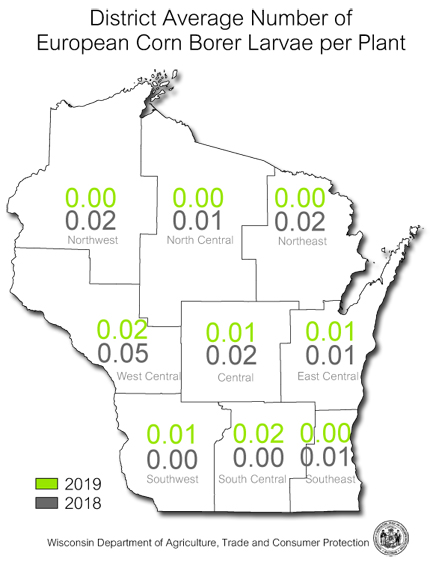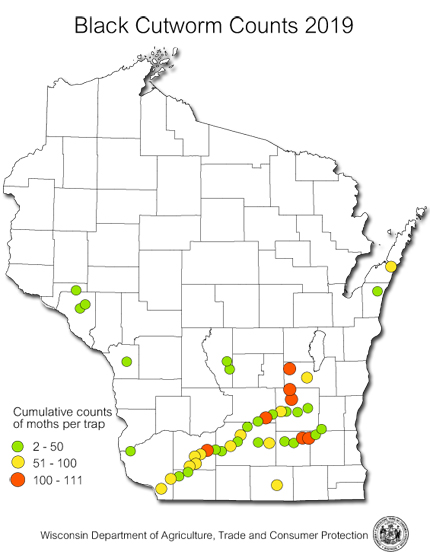
 |
|
|
Corn
Volume 64 Number 19 Date 11/07/2019 A THANK YOU TO BILL VEITH - After 15 years of dedicated cooperation with the Pest Survey Program, Bill Veith, Agronomist with Seneca Foods in Janesville, will be retiring on December 31. Bill has contributed a valuable long-term data set during his tenure, and his Janesville location was particularly useful for tracking insect migrations. He was always ahead of the curve in documenting moth flights. A review of Bill's stats shows that he has counted 27,177 nocturnal moths in his traps in the last decade and a half (6,152 in 2019 alone!), with an annual average of 1,812 moths! Numerous Bulletin readers have benefited from Bill's sentinel insect observations over the years, and his retirement leaves a significant gap in our program's reporting. All of the staff in the DATCP Pest Survey extend our deep gratitude and best wishes to Bill in his retirement. CORN ROOTWORM - Beetle populations increased from historically low levels in 2017-2018, but remained low overall. The state average count in 229 cornfields sampled in August was 0.3 beetle per plant, which is only marginally higher than the all-time low average of 0.2 per plant recorded during the two preceding seasons. For the third year in a row, average counts remained at or below 0.3 beetles per plant across all six central and northern crop districts and the southeast region, while increases were limited to the south-central and southwest districts. Averages in these two districts rose from 0.3 beetle per plant last year to 0.5 per plant in 2019. Above-threshold populations of 0.75 or more beetles per plant were found in 27 of 229 (12%) fields surveyed this season, compared to last year's 20 fields (9%). No beetles were observed in 120 (52%) of the sites. The 2019 total count of 711 beetles was 26% higher than the 566 beetles recorded in 2018. CORN EARWORM - Pheromone traps captured a cumulative total of 3,495 moths (15 traps) during the late-season monitoring program, with the largest flights recorded during the last two weeks of September. The highest individual pheromone count was 589 moths at Mayville in Dodge County from September 19-25, while the Janesville black light trap registered its highest weekly total of 932 moths from September 26-October 2. Compared to 2018 when 7,905 moths were collected in 15 pheromone traps, this year's total count was markedly lower. Although this would suggest the risk to late sweet corn from migrating corn earworm moths was also much lower in 2019, the September CEW flights produced localized larval damage to apples, corn and tomatoes this fall. EUROPEAN CORN BORER - Larval populations remained historically low for the second consecutive season. The 2019 fall European corn borer survey found a state average count of 0.01 borer per plant, tying 2018 for the lowest population in 78 years. Seven of the state's nine agricultural districts showed averages less than or equal to 2018 levels, while negligible increases were noted in the southwest and south-central areas. Larvae were absent from 89% of the 229 sampled fields in September and October. The exceptionally low ECB pressure documented by the fall survey should provide reassurance to growers who planted non-trait corn seed in 2019, though conventional acreage will continue to require a higher level of scouting and management to address local variability in seasonal ECB abundance. BLACK CUTWORM - Unprecedented planting delays and wet, weedy field conditions contributed to an elevated threat of cutworm damage this spring. Moths appeared by April 4 and substantial migration flights occurred throughout May. The April-June trapping survey captured 1,271 moths in 44 traps, with an individual high count of 111 moths near Waupun in Dodge County. In 2018, the survey collected 2,217 moths in 47 traps. Late corn planting resulted in a protracted primary larval damage period that extended throughout June, but contrary to expectations, black cutworm damage to emerging corn was not prevalent this spring. WESTERN BEAN CUTWORM - Moth counts and larval injury to corn increased in 2019 compared to the year before. The annual trapping program from June-August registered an average of 65 moths per trap (3,600 moths in 55 traps), the second highest average in 15 years. The survey record of 79 moths per trap (10,807 moths total) was set in 2010. The highest individual count for the 10-week monitoring period was 405 moths at Princeton in Green Lake County. This season's relatively large flight generated larval infestations in central and southern areas of the state that traditionally experience western bean cutworm problems, though widespread damage not observed during fall corn pest surveys. -- Krista Hamilton, DATCP Entomologist SEED CORN INSPECTION - Inspection of Wisconsin seed cornfields found no bacterial diseases of export significance this season. All 49 corn leaf samples tested at the Plant Industry Lab were negative for Goss's wilt, Stewart's wilt and bacterial leaf streak (Xanthomonas vasicola pv. vasculorum). Three fungal pathogens, common rust (48%), grey leaf spot (33%) and anthracnose (22%), were commonly observed. Certification for virus-caused diseases showed no high plains disease, wheat streak virus, or maize chlorotic mottle virus. One sample in Dane County tested positive for sugarcane mosaic virus (formerly maize dwarf mosaic virus). -- Anette Phibbs, DATCP Plant Pathologist 





|
|
|